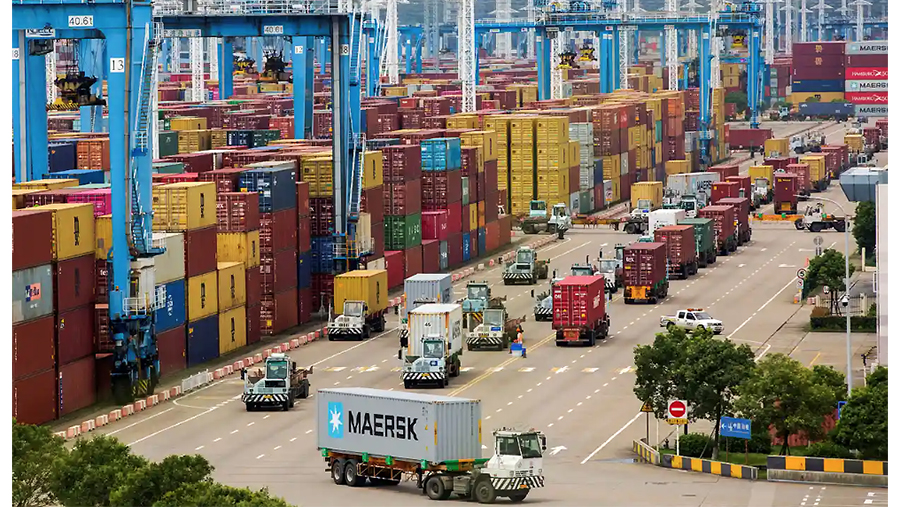An online webinar, hosted by the National Sporting Goods Association (NSGA), found executives from CCM Hockey, Johnson-Lambe and Sports Specialists Limited agreeing that ongoing supply chain disruption would likely linger through 2023, reshaping buying patterns and strategies.
Johnson-Lambe Leans Into Relationships
Rhett Johnson, owner, Johnson-Lambe, the team dealer in Raleigh, NC, said the supply chain disruption over the last two years had “completely changed how we do our business,” including whom his company conducts business with.
“The buying patterns we used to have in this industry are completely gone,” added Johnson. “Now it’s buying all you can get, and when you can get it, grab it.”
For example, he noted that Johnson-Lambe typically has minimal inventory this time of year after selling its merchandise for the fall sports seasons; however, it has already received half its shoulder pads orders for the coming spring, as well as its spring baseballs and softballs. Johnson said, “It’s upset the apple cart as far as how inventory goes, managing inventory and having to pay for that inventory.”
Johnson also said that the inventory disruption had “exhausted” his staff. Having talked with other dealers, they agreed that their reps are working “twice as hard as they have ever done just to reach the same outcome as in the past.”
Johnson added, “We were fortunate. Johnson-Lambe’s August and September this year were our two best sales months in our 87-year history, but our people were redlined because of all the extra work they had to put in to ensure they found the inventory.”
The cost of goods has also risen, which adds to his sales team’s workload as the company must adjust prices continuously. However, Johnson felt the move to raise prices could be a “silver lining” out of the supply chain crisis resulting in a healthier margin for the overall team business. Said Johnson, “I feel like our industry for the last 20 years has been a race to the bottom on price. We’ve been very stagnant, and none of us ever go up in price every year, and this has given us the green light. We can all raise our prices and return to making the margins we should be making.”
Looking ahead, Johnson suspects the supply chain squeeze will ease by the end of 2023 but also described his assessment as “completely a guess,” with his sales team already working with vendors to avoid shortages for the back half of 2023.
Moreover, Johnson believes the disruption will likely permanently alter how team buying is done, focusing on early ordering. He said, “We can’t rely on the vendors to be that fill-in bucket for us like we used to, and we’ve got to adjust that. And when we do that, that’ll correct a lot of problems, at least on our side. It’s a band-aid, but I think it will help.”
Beyond ordering early, he believes dealers should be “proactive” in bringing potential solutions to their vendor partners. He also believes communication will remain critical to work through issues. He said, “People can handle good news, people can handle bad news, what they can’t handle is no news.”
Johnson overall said the experience had reinforced his belief that relationships remain integral to the team sports business. He said, “When times are bad, you can fall back on those relationships. And that’s been the key to getting through this whole thing.”
Sports Specialist, Ltd. Stresses Early Orders
Tyler Lockard, interim president and hardgoods merchandise manager, Sports Specialist Ltd. (SSL), the buying group for snow sports and the outdoor space, remarked that retailers placed orders for the coming winter season “about a month earlier than we ever have in the past” due to the inventory delivery risks.
For instance, orders for hardgoods were placed around the beginning of February when they are traditionally placed in March. For apparel, orders started to take place in November and December. The result is that orders are being made well before the fashion trends have been established on the apparel side as well as weeks before the on-snow demos occur for hardline products. Said Lockard, “That inability to necessarily know 100 percent what is going to be right for you has put a burden on the retail community.”
Retailers are also being encouraged to place all their inventory buys upfront to avoid shortages, said Lockard. Traditionally, about 80 percent of buys represented pre-season orders, with reorders representing 20 percent. Now, about 90 percent to 95 percent of orders are pre-season. Key items often reserved for reorders also tend to be unavailable, he added.
Retailers are also receiving inventory significantly earlier than traditionally. Lockard noted that this presents challenges around storage as stores are often still packed with spring/summer merchandise, and finding outside warehouse space for retailers has become more expensive.
Another challenge has been the rising cost of goods due to higher underlying costs related to raw materials, shipping containers and wages. Said Lockard, “We have now, over this last year, seen at least, on the hardgoods end, about a 10 percent increase in the cost of goods with more potentially coming down the horizon.”
He noted that retailers also face higher rent and labor costs.
One positive side-effect is that higher prices are being passed through to offset these pressures, and Lockard believes it is helping the industry’s profitability.
Lockard said that the ski industry had been challenged maintaining adequate margins even before the pandemic as prices for skis and boots stayed relatively the same for about two decades. Over the pandemic, some equipment makers weren’t making any money, forcing what he sees is an overdue price reset, he noted.
“I believe it is in everyone’s best interest to increase the price of goods moving forward,” said Lockard. “There is a cap to that, too, where we’re no longer going to be able to do some, and we’re going to have to plan accordingly beyond that. But right now, I think we have rectified the issue at hand by reframing what the costs are for a ski or a boot.”
Another benefit of the inventory challenges is that retailers can sell seasonal products earlier due to heightened demand and because consumers realize the product may be unavailable on their next shopping trip due to supply chain disruption. He noted that consumers had often waited for a major discount at the annual spring sale. Said Lockard, “We have, to a certain extent, retrained the consumer over the last year, year-and-a-half to where we can effectively tell them that this inventory might not and probably will not be available towards the end of the season. And on a positive note, this protects our margin as well.”
Lockard’s suggestions to retailers include placing orders “as early as possible.” Also, placing multiple shipments with each supplier, with some winter goods arriving in September, then others in October and December could ease warehousing pressures. He also advised close communications with the brands and their reps to stay in front of supply chain issues and to ensure inventory hits the selling floor on time. He said, “Unfortunately, I don’t necessarily see any change from where we currently stand in the years ahead.”
CCM Hockey Focuses On Front-End Loading
CCM Hockey’s shipments were approximately 30-to-45 days delayed on average in 2022 versus the last “normal” pre-pandemic year in 2019, said Kevin Sodhi, the manufacturer’s head of supply chain and operations, resulting in late deliveries to customers for the just-started hockey season.
The equipment manufacturer was hurt by China’s COVID-related lockdowns, with 95 percent of its production coming from Asia.
From a product launch perspective, quality issues arrived as CCM could not adequately inspect product before production due to travel restrictions. Delays were also caused by late-arriving raw materials and labor shortages, including at distribution centers. Inflationary pressures caused challenges from a cost standpoint.
Looking to 2023, Sodhi said lead times are shortening as shipping lanes improve and access to raw materials is also improving, but labor shortages, inflation and geopolitics, including the Ukraine war, remain challenges. Said Sodhi, “It’s not going to get easier necessarily. We just have to get better at how we manage it.”
To help mitigate disruption going forward, CCM is working on diversifying its sourcing base to be less dependent in Asia while focusing more on supplier performance and investing in inspectors at the factory level to reduce quality risks.
From a purchasing standpoint, the focus will be more on front-end loading. Sodhi shared, “Typically, we would order to customer demand. Now, we’re ordering with our vendor base to forecast so that we can take advantage of some upfront capacity and try and get the product ready to ship earlier than it was in 2022.”
Investments have been made in technology and labor at its distribution center to better turn around potentially late-arriving products.
Bill Terski, CCM’s senior director and head of sales, U.S., suggests retailers and team dealers get in bookings at the first deadline. He said, “It gives us visibility to trends, size demands, raw material – things that we may need to ensure we’re maximizing our supply chain and ensuring that we have the time to do so.”
Terski noted that 80 percent to 90 percent of team sizes are the same yearly, and ordering early often earns a discounted rate. Other advice included not overly relying on fill-ins because of the continued risks around inventory availability. Terski said, “Bookings are always a priority for us and the best way to ensure you have your inventory for the upcoming hockey season.”
Suggestions to retailers and team dealers also included early conversations with sales reps or customer service teams to explore alternatives to make up for potential inventory imbalances and provide feedback to manufacturers for vendors to stay in front of trends and supply chain hurdles. Terski said, “Ideas, challenges and opportunities that you see on the sales floor on a day-to-day basis can become opportunities for manufacturers to help you meet consumer demands.”
Photo courtesy Reuters
















